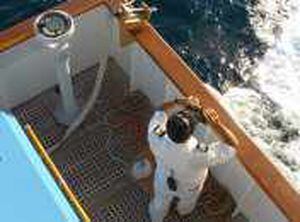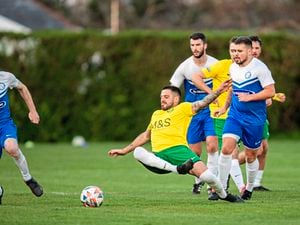Torrents of Arabia
IT ALL seemed like a joke at first: we were sailing in a modern, luxurious cruise liner, watching out for pirates. Emergency drills, extra crew on watch and the presence of a senior military adviser brought reality to mind, although the British spirit was always popping up.

IT ALL seemed like a joke at first: we were sailing in a modern, luxurious cruise liner, watching out for pirates. Emergency drills, extra crew on watch and the presence of a senior military adviser brought reality to mind, although the British spirit was always popping up.
'What are we to expect?' guests asked. 'Do pirates fly the skull and crossbones? Will the pirate captain have a black patch over his eye and a parrot on his shoulder?'
We were sailing across the northern Indian Ocean, towards India, our route sandwiched between Yemen and the pirate stronghold of Somalia.
In the past week there had been four attacks on merchant shipping, with two vessels successfully hijacked. It was reassuring to learn, however, that no cruise ship has ever been captured. The owners of my ship do not want its name mentioned.
Piracy off Somalia has become big business, with the highest ransom paid now topping US$9m.
Pirates are arrested regularly and their mobile phones are proving great sources of information. It seems that European and American 'investors' are funding the pirates and taking a cut of their ill-gotten gains.
The pirates are desperate people operating out of a lawless country, the government of which has lost control of the tribes of people who live along its coasts.
They use aluminium skiffs, which are extremely fast, powered by huge outboard motors - illegally funded by their foreign backers. Each skiff has a crew of about six men, often armed and distinguished from small fishing boats (of which there are thousands in the area) by a long ladder carried on board. The ladder juts out to the front and has a metal hook at the end - used to attach it to the victim ship.
In the early days of Somali piracy, the boats attacked from their land bases, targeting vessels reckless enough to take a shorter inshore route to or from the Red Sea. But as captains started to give the country a wide berth, new tactics were employed. Captured vessels were used as 'mother ships' from which skiffs were launched many hundreds of miles out to sea, giving a far greater range to the pirates.
Of the two vessels captured before we passed through the area, one was taken 600 miles south-east of Mombassa and the other 1,300 miles east of Somalia.
The business is growing, too. Just 15 ships were taken in 27 attempts in 2005, but this rose to 39 seizures from 124 attempts in 2009.
The figures for last year were 40 successful captures from 94 attempts, showing a higher success rate as the pirates become better equipped and more experienced. In all, about 150 ships have been taken in the last six years.
The toll in human misery and ransoms paid is enormous. All captured ships are taken to anchorage near Eyl, Garacaad or Hobyo, Somalia, where their crews face a wait of up to seven months while negotiations take place.
Captured crew can expect minimal basic food, intimidation, theft of everything valuable on the ship and the ransacking of their quarters. Pirates, we were told in a fascinating talk by security adviser Captain Nigel Bassett, had no knowledge of lavatories or hygiene. He was responsible for the wide-ranging and effective measures taken to deter pirates from our ship.
Our first line of defence was education. All cruise ships begin a tour with a mandatory safety drill, which includes donning lifejackets, assembling at muster stations and receiving detailed instructions on what to do in an emergency. Our cruise, which started in Aqaba, Jordan, was no exception.
The exercise was followed, however, with a second drill to show us what to do if the ship were to come under attack.
Here, procedures were aimed at getting passengers away from the sides of the ship, windows and portholes. In my case, I was to stand in the corridor outside my cabin with my lifejacket, which could be used as a cushion if a prolonged attack should take place.
It was repeated a few days later, just before we rounded Aden and entered the Indian Ocean.
I have to say that the chances of us being attacked were minimal, so comprehensive were our defences. Any pirate giving us the once-over would have seen immediately that the ship was well prepared.
And that is what our defences were intended to do.
Every low deck on the ship had razor wire attached to rods along the seaward side. This was further defended by live electric wires, which would have given any pirate not cut to ribbons a severe jolt. Signs to this effect in Somali were placed along the side of the ship, although whether the pirates can read is another matter.
Attack from the rear was rendered impossible by trailing floating lines behind the ship. These would have caught around the pirates' outboard propellers, crippling their skiffs, which would then have been towed backwards behind us.
Perhaps the most effective anti-boarding measures - and which were seen from a great distance - were water cannon pumping seawater over the side of the ship. Any skiff coming alongside would have filled with water in seconds and sunk.
Many vessels in the area used this precaution. We saw lots with skirts of water draped around their sterns and several where the whole ship was encased in a wall of self-generated water.
Extra lookouts were posted, especially in the early morning and late evening, when most attacks are launched, and two Ribs were slung over the port and starboard sides ready to be launched. We were never told what occupants would have done once afloat.
It is, of course, illegal under maritime law to fire on small vessels in open waters. Trigger-happy security guards would kill far more innocent fishermen than pirates, one suspects. Not that this influenced some of the passengers who believed that pirates should be blown out of the water. (Who would pull the trigger, however, was less clear.)
Ships act together as a further defence, grouping in parties to pass through the area in convoys (this term was resisted strongly by Mr Bassett, but that is what they amounted to).
Warships from the United States and France patrol the area and have helicopters on board which can be called up if an attack were to take place. I saw only my second aircraft carrier at sea, on patrol to help defend us.
That I am writing this feature is testament to the effectiveness of our defences, which also added a fascinating dimension to our cruise around Arabia.





